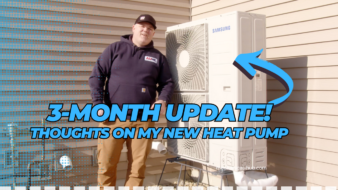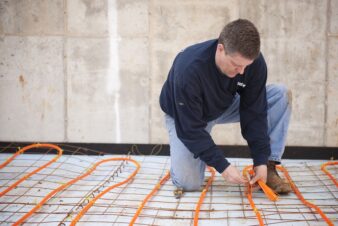by Rob Spence (Mechanical Engineer) and Abigail Cantor (Chemical Engineer)
Introduction
This article is part of a series discussing the growth of microorganisms in plumbing systems. As previously noted, microorganisms can grow and thrive in a plumbing system when water that enters a system is not used for a long time. This article looks at sizing pipes and tanks in order to minimize the volume of water stored on-site and the residence time of water in the plumbing system.
Current plumbing and home designers are at odds with this desire to reduce system volume. New homes and bathroom remodels are incorporating multiple head showers, body sprays, and large whirlpool tubs. This drives up the plumbing system requirement with larger pipes, water heaters, water softeners, expansion tanks, and filtration units. Many times the added capacity is only utilized a fraction of the time, which results in very long residence times.
Fixture Units
Residence time can be addressed first in design by considering “fixture units”. The Plumbing Code assigns a fixture unit to each type of device in the plumbing system so that pipes can be properly sized with adequate flow and pressure to each fixture. The plumbing designer must tally up all the fixture units serviced by each segment of the piping system (hot, cold, combined, branch, and mains) and size the pipes accordingly. Therefore, as we add bathrooms, whirlpool tubs and extra shower heads, the pipe sizes must get larger.
Let’s contrast a typical home with 2 ½ baths utilizing single shower heads to a luxury home with 3 full baths and two ½ baths. One of the luxury baths will have a rain head shower and a hand-held spray plus six body sprays, as well as a 75 gallon soaking tub.
In our example, the luxury house fixture count would require 1¼” supply line and 1” hot and cold mains with a 1” branch just to the master bath. The shower alone could have a fixture count as high as 15. In contrast, our standard home would only require a ¾” main. Note that the 1¼” supply pipe in the luxury house has over six times the volume of water per linear foot than the standard ¾” supply pipe. The Code doesn’t allow us to reduce the pipe size in these cases, but there are things we can do to reduce the load on the pipe so that the number of fixture units are lowered and the pipe sizes are calculated to be smaller.
Consider using diverting valves in shower systems rather than volume controls or separate valves on each device. This lets the user choose only one of the multiple heads at once rather than the ability to have all functions at the same time. Some of the pre-assembled shower towers utilize this functionality as well as low flow body sprays, so they only require ½” supply lines. Contrast that with a luxury shower with individually mounted body sprays, which would require a 1” equalization loop going to all six locations. As you can see by utilizing a shower tower or diverting valve you only have to count one of the devices in the shower, which reduces the pipe sizes in the shower, branch circuit, and even the mains. This choice reduces piping system volumes as well as labor for installation!
One other plumbing option to consider for reducing pipe volume is a “home run system”. This is a design where manifold pipelines host connections to groups of fixtures instead of each fixture connection branching off from the main piping all through the building. This type of system utilizes individual ½” or ¾” lines to each fixture or bath group. The design will typically increase the overall linear feet of piping, but because it is smaller diameter pipe, the system volume is less.
Hot Water Tank Volume
As with considering fixture units, the Plumbing Designer must also adequately size a hot water heating system to handle all the potential flow. The Code states that the design “must provide adequate hot water for peak load”. With traditional tank-type systems, our luxury home might need to be designed with several hundred gallons of storage. We’ve all heard it: “This is a high end customer and they don’t want to run out of hot water”. So, the system is designed with multiple large tank-type heaters or a boiler system with several indirect tanks. All of this hot water is sitting and waiting for one or two days per year when it is really required. It makes sense to consider tankless water heaters that do not store any hot water. It is true that in some cases, it will require two or three tankless water heaters. But, the risk for damaging biofilm growth is greatly reduced.
Educate the home owner of the risks of over-sizing the domestic hot water package. By utilizing the diverter valves in the shower system, we can get by in our luxury home with only two tankless water heaters. In addition, the Plumbing Code now gives an alternate method for sizing tankless heaters. It allows the designer to base the heater size on 65% of the peak fixture load. Using this method, our typical home only requires one tankless heater.
One other method of reducing water heater tank volume is the use of an indirect water heater mated to a boiler system. Typically, these systems have higher recovery rates (rates of heating and re-heating water), so many times a smaller hot water storage tank can be used than in direct heating. For example, a standard 75 gallon gas water heater has a first hour delivery of 120 gallons per hour (GPH) compared to a 30 gallon indirect water heater that is rated at 183 GPH. In this comparison, there is an increased first hour delivery rate for indirect water heaters with a tank volume reduced by 45 gallons.
For water systems with private water sources, utilizing a constant pressure well pump will also decrease system volume. A typical expansion tank for a standard well pump is 50 to 75 gallons. However, that drops to 5 or 10 gallons on a constant pressure pump system.
We’ve been talking about decreasing system volume to reduce the risk biofilm growth, which is the primary goal of this article. However, if it is determined that the system must have large hot water storage tanks, the design temperature of those tanks can be elevated to a much higher temperature (160 to 180 degrees F) to prevent biofilm growth. This system must be fitted with an anti-scald valve to reduce the temperature to a safe level for the distribution to the house. Indirect water heaters are a good choice for this type of system since they typically have a much lower energy loss as the water sits in the storage tank.
The Tub Dilemma
The required hot water tank volume also depends on the fill rate of bath tubs. Large whirlpool tubs typically have tub fillers capable of 12 to15 gallons per minute (gpm). Most designers would recommend an additional hot water storage tank at least as large as the tub volume, since no tank-type heater will keep up with 15 gpm fill rate. Again, this requires large piping and major domestic hot water heating equipment that can lead to the growth of biofilms.
However, plumbing designers can educate homeowners about this dilemma. If a homeowner can accept a slightly lower fill rate for the tub, one or two tankless water heaters can be used instead of a large tank-type heater with hot water storage. In addition, the tankless heaters will maintain outlet temperature indefinitely so that there will be no drop in temperature as the tub slowly fills. With a large tank-type water heater and additional large storage tank, a 75 gallon tub could potentially fill in 5 minutes. With one tank-less water heater, the max fill time would be, at worst, 15 minutes.
There are a few issues that must be considered when applying a tank-less heater. There is a phenomenon called a “Cold Water Sandwich.” That is, the first gallon or two of water is room temperature because it has been sitting in the room’s piping. Then, the cold influent water comes in and has not had adequate time for heating, so there is about 3 to 5 seconds of cold water. Then the properly heated water arrives. A person can’t jump right into a shower or a bath tub and can’t turn the water on and off repeatedly. But, a 2 to 5 gallon buffer tank can be used to solve the cold water sandwich problem.
Another issue is that there is higher pressure drop in tankless water heater units which must be considered in the plumbing design.
Water Treatment Equipment
The water softener and other water treatment equipment are also sites of large residence times. As plumbing features of a luxury home are added, the peak flow rate increases. This large flow rate alone given to a water treatment designer may result in very large water softening and treatment system. However, the homeowner can describe the intent of how the luxury plumbing features will be used. If the use of multiple luxury features is only going to occur for a short period, say 10 to 15 minutes every few weeks, consider installing a smaller softener and any other required water treatment equipment. As long as the connections to the softener and other water treatment equipment are sized to handle that flow, the momentary surge will only result in partially softened/treated water going down stream for that short period. Size the water treatment equipment for every day flow.
Hot Water Recirculation Lines
Hot water recirculation lines are needed in larger buildings so that hot water is immediately available throughout the building instead of having to travel from the hot water tank first. However, hot water recirculation lines are notorious for biofilm growth because of added residence time of water and because the recirculation serves as a means to spread microbiological colonies to previously unaffected parts of the hot water system.
The “home run” plumbing system discussed in the section about “Fixture Units” can eliminate the need for a hot water recirculation line.
Summary
In summary, it is difficult to lower water residence time and water volumes in modern plumbing systems, but it can be done.
Using diverting valves, shower towers, or home run system design can decrease the number of fixture units in a plumbing design. This will result in smaller piping and decrease the size of heating and water treatment equipment.
Homeowners can be encouraged to choose tank-less water heaters and to accept lower tub fill rates to drastically reduce system volume. Where tank-type water heaters are used, indirect heaters require less hot water storage than direct heaters.
Water softeners and other water treatment equipment can be sized for typical daily flow if peak flows are minimized by the homeowner.
Volume can be reduced further on systems with private water sources by using constant pressure well pumps.
We can’t expect plumbing designers and consumers to eliminate all the luxuries that we have grown accustom to. But, as a plumbing community we need to be smart with our designs and educate our customers on the consequences of over-engineering. With very small concessions, consumers can enjoy substantial energy savings as well as lower risks to health and to pipe integrity.




Join the conversation: